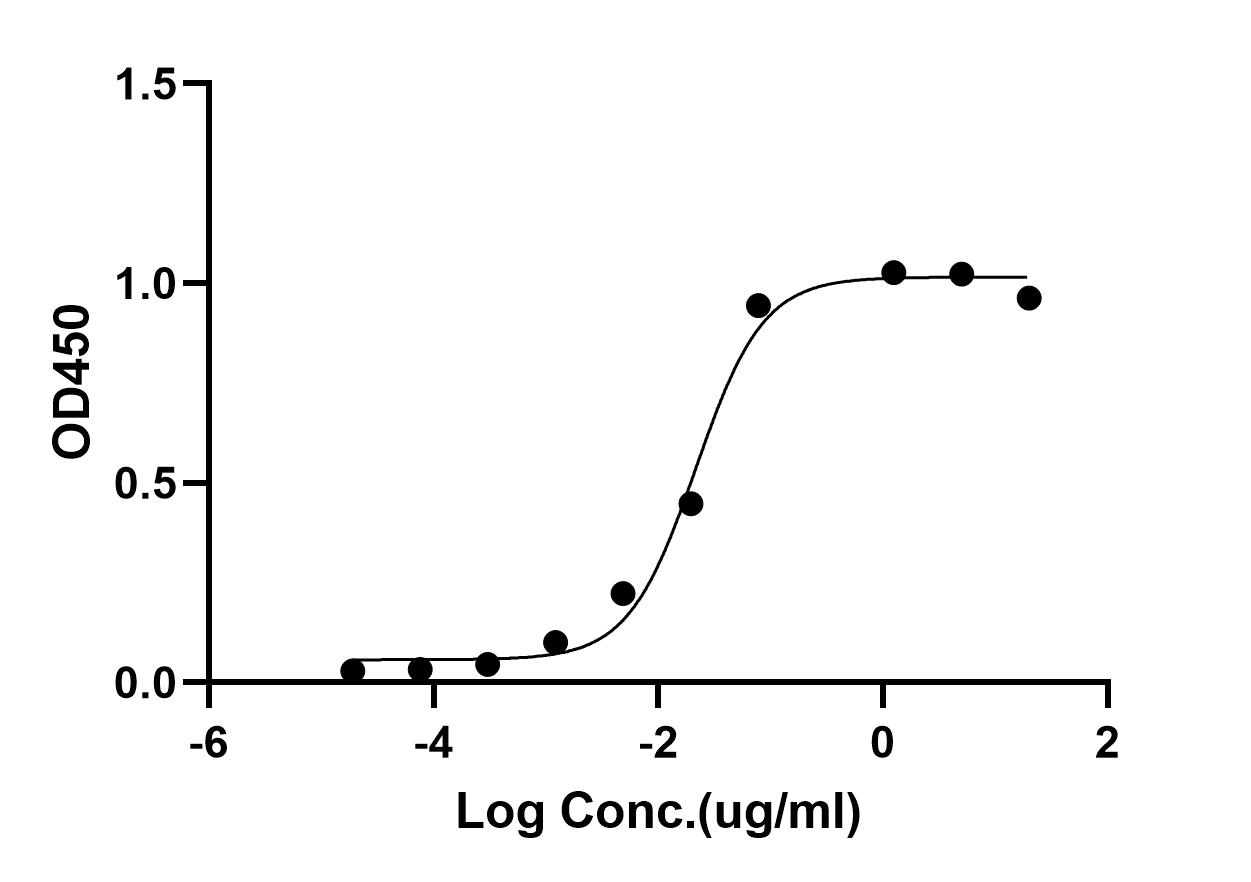CD166 (PN0352) Nb-FC recombinant antibody
- Catalog No.:YA0126
- Applications:ELISA
- Reactivity:Human
- Target:
- CD166
- Gene Name:
- ALCAM MEMD
- Protein Name:
- CD166 antigen (Activated leukocyte cell adhesion molecule) (CD antigen CD166)
- Human Gene Id:
- 214
- Human Swiss Prot No:
- Q13740
- Immunogen:
- Purified recombinant Human CD166
- Specificity:
- This recombinant monoclonal antibody can detects endogenous levels of CD166 protein.
- Formulation:
- Phosphate-buffered solution
- Source:
- Camel, chimeric fusion of Nanobody (VHH) and mouse IgG1 Fc domain , recombinantly produced from 293F cell
- Dilution:
- ELISA 1:5000-100000
- Purification:
- Recombinant Expression and Affinity purified
- Concentration:
- Please check the information on the tube
- Storage Stability:
- -15°C to -25°C/1 year(Avoid freeze / thaw cycles)
- Other Name:
- ALCAM;MEMD;CD166 antigen;Activated leukocyte cell adhesion molecule;CD166
- Background:
- This gene encodes activated leukocyte cell adhesion molecule (ALCAM), also known as CD166 (cluster of differentiation 166), which is a member of a subfamily of immunoglobulin receptors with five immunoglobulin-like domains (VVC2C2C2) in the extracellular domain.This protein binds to T-cell differentiation antigene CD6, and is implicated in the processes of cell adhesion and migration. Multiple alternatively spliced transcript variants encoding different isoforms have been found. [provided by RefSeq, Aug 2011]
- Function:
- domain:The CD6 binding site is located in the N-terminal Ig-like domain.,Cell adhesion molecule that binds to CD6. Involved in neurite extension by neurons via heterophilic and homophilic interactions. May play a role in the binding of T- and B-cells to activated leukocytes, as well as in interactions between cells of the nervous system.,similarity:Contains 2 Ig-like V-type (immunoglobulin-like) domains.,similarity:Contains 3 Ig-like C2-type (immunoglobulin-like) domains.,tissue specificity:Spleen, placenta, liver, and weakly in liver. Expressed by activated T-cells, B-cells, monocytes and thymic epithelial cells. Expressed by neurons in the brain. Restricted expression in tumor cell lines. Preferentially expressed in highly metastasizing melanoma cell lines.,
- Subcellular Location:
- Cell membrane ; Single-pass type I membrane protein . Cell projection, axon . Cell projection, dendrite . Detected at the immunological synapse, i.e, at the contact zone between antigen-presenting dendritic cells and T-cells (PubMed:15294938, PubMed:16352806). Colocalizes with CD6 and the TCR/CD3 complex at the immunological synapse (PubMed:15294938). .; [Isoform 3]: Secreted .
- Expression:
- Detected on hematopoietic stem cells derived from umbilical cord blood (PubMed:2474813). Detected on lymph vessel endothelial cells, skin and tonsil (PubMed:23169771). Detected on peripheral blood monocytes (PubMed:154873). Detected on monocyte-derived dendritic cells (at protein level) (PubMed:1635286). Detected at low levels in spleen, placenta, liver (PubMed:952422). Expressed by activated T-cells, B-cells, monocytes and thymic epithelial cells (PubMed:7767). Isoform 1 and isoform 3 are detected in vein and artery endothelial cells, astrocytes, keratinocytes and artery smooth muscle cells (PubMed:15496415). Expressed by neurons in the brain. Restricted expression in tumor cell lines. Detected in highly metastasizing melanoma cell lines (PubMed:952422).
- June 19-2018
- WESTERN IMMUNOBLOTTING PROTOCOL
- June 19-2018
- IMMUNOHISTOCHEMISTRY-PARAFFIN PROTOCOL
- June 19-2018
- IMMUNOFLUORESCENCE PROTOCOL
- September 08-2020
- FLOW-CYTOMEYRT-PROTOCOL
- May 20-2022
- Cell-Based ELISA│解您多样本WB检测之困扰
- July 13-2018
- CELL-BASED-ELISA-PROTOCOL-FOR-ACETYL-PROTEIN
- July 13-2018
- CELL-BASED-ELISA-PROTOCOL-FOR-PHOSPHO-PROTEIN
- July 13-2018
- Antibody-FAQs
- Products Images

